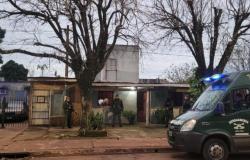
“If prisoners escaped from places that have 16 to 26 detainees, How can we trust that they are going to control a place that is going to have many more?“. That is what they ask themselves, in dialogue with Page 12residents of the neighborhoods of the City of Buenos Aires in which the Buenos Aires government will begin to install “prison modules” to alleviate the overpopulation crisis of police stations and wardens, which in April resulted in four leaks in the span of two weeks. And they also maintain that the modules are really “container prisons” with conditions “inhuman“and warn that were not consulted about the measure prior to the announcement.
The surroundings of Los Andes Park They woke up this Tuesday with the noise of cranes and trucks. Loaded in the trailers, four container modules appeared on Jorge Newbery and then were entered into the premises of the Communal Police Station No. 15, on Guzmán and Concepción Arenal streets, where there are detainees housed today. Forty days after the official announcement of the GCBA, the residents of the area saw the first step for the installation of the modules materialize, which until now there had been no progress concrete. According to the Buenos Aires government, the containers will be placed, in an articulated manner, on the playgrounds or parking lots of three police stations: 15 Chacarita12 Ramallo at 4398, neighborhood of Saavedraand the 4D of California 1850, Barracks.
“Seeing those modules up close gives even more impression.. One reads the official project and immediately notices that it is subhuman what they propose does not seem to be very in line with human rights,” Débora Engel, a member of the organization, now tells this newspaper. Chacarita Environmental Protection, which began discussing the issue in meetings in the weeks after the announcement. “It’s not that we don’t want prisoners in our neighborhood.. What we reject are the conditions under which they want to do it. We believe that This is not how the overpopulation situation is resolved.“warns the neighbor.
According to official information, the modules to be installed are 57, divided into three groups of 19 to be distributed among the three properties. There they will stay 300 detainees, at a rate of six people per container. Each of the modules has six mattresses in three bunk beds, while in the central part of the structure there will be a small space with metal tables and benches for lunch. The place will be surrounded by “high security perimeter bars“, according to the Ministry of Security. The announcement of the modules was accompanied by the construction of a new central warden and the completion of the works of a new prison in Marcos Paz
“We do not understand the reason for the ‘genius’ of putting prison modules, theoretically provisional, until Marcos Paz is finished.Why don’t they put them directly there?“?” asks Cecilia, a resident of Barracas, a neighborhood where they are also organized to reject the project. “It makes no sense to have prisons spread out in urban areas when what is always sought is precisely the opposite: that the prisons leave the city,” he adds.
In the case of Barracas, the modules will be installed in an area that, according to residents, work two schools, two clubs, a church and a nursing home. In the surrounding area there are also social inclusion centers, known as “paradores”, for people experiencing homelessness. The people of Barracuda have already been denouncing the malfunction of those centers. They assure that the people suffer abuse, insecurity problems, robberies and violent acts that also alter the life of the neighborhood, and it is they themselves who end up helping the people expelled from those places.
“With all that we They show that they cannot control these types of places because we end up helping people. And a prison cannot be run by people who are not trained. “If prisoners escaped from places that have 16 to 26 detainees, how can we trust that they will be able to control a place that will have many more?” says Cecilia.
Although the crisis of overcrowding in police stations and wardens has been going on since last year, it gained attention on the public agenda when at the beginning of April there were four leaks in just the first fortnight of the month. The events occurred in police stations and wardens of San Telmo, Caballito, Balvanera and Villa Urquiza, all prepared only to receive temporary detainees. In all of them a excess capacity to house prisoners at the time of escapes. According to official numbers, today there are around two thousand detainees in places with capacity for close to a thousandwithin the framework of a city without its own prison service.
The figures also indicate that more than 95 percent of these prisoners correspond to processes carried out by the jurisdictions federal and nationaldata that serves the Buenos Aires administration to sustain its asked the Nation to take the detainees to the Federal Penitentiary Service, a claim that even sparked public disagreements between the Buenos Aires Minister of Security, Waldo Wolff, and the national minister, Patricia Bullrich. Finally, the minister participated in the announcement of the installation of the prison modules, which seemed to indicate, at least for the moment, the end of these acrimonies.
Both in Barracas and in Chacarita agree that were not consulted at any time about the installation of the modules in their neighborhoods. “We were not summoned as neighbors in terms of citizen participation that is never fulfilled. Only recently did we manage to obtain a meeting with the Community Board but we do not have a date,” warns Engel. In recent weeks the groups from the two neighborhoods were in contact to organize common activities.
In Chacarita, the conflict over the installation of the modules is added to the situation of the property on which they will be placed. The block in which the police station and a monitoring center operates includes the land on which a survey has been planned for thirteen years. sports Center, one of the main claims of Amparo Environmental Chacarita. “Of the entire property, we only had the land left to build the sports center. If completed, today it would be framed by a police station, a monitoring center and now the detention modules, a very nice space to do sports…”, ironically, in closing, the neighbor of Chacarita.





